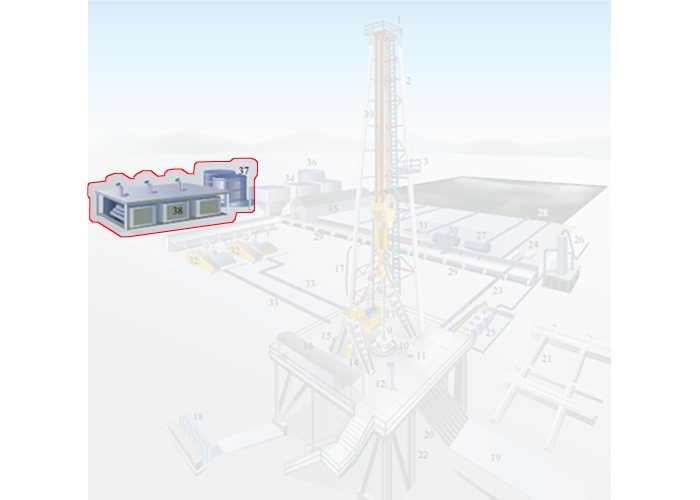The power system on a drilling rig provides the power for the other main systems on the rig and other ancillary systems, such as electrical systems, pumps, etc. The system typically consists of a prime mover (the component of the power system that generates the raw power) and a means to transmit the raw power to the end-use components on the rig.
In the detailed rig schematic (Figure 9.02a), the power system is comprised of:
- the Fuel Storage (Item 37)
- the Engines and Generators (Item 38)

Historically, coal was used to generate the power for drilling rigs; however, modern drilling rigs use other sources of fuel. Typically, modern rigs are now run using an internal combustion engine with diesel or lease fuel. Diesel oil is a petroleum-based fuel that is a product of the distillation process. If the rig is running in a developed field, then the field may have a small on-site refinery that is used to distill the diesel fuel. If the rig is drilling an exploration, appraisal, or delineation well, then the fuel will need to be delivered from an external source and stored on-site.
Lease fuel is typically produced natural gas. As we have learned, natural gas is always produced along with crude oil. Again, if the rig is drilling wells in a developed field, then the field may use the natural gas or Natural Gas Liquids (NGL) to fuel the prime mover. This natural gas may be processed to remove NGLs if a gas plant is available on site; may need to burn these hydrocarbon liquids (possible sales product) if a gas plant is unavailable; or may burn the processed NGLs (butane).
The transmission of the power can be:
- mechanical
- direct current (DC) electrical generator
- alternating current (AC) electrical generator with silicon-controlled rectifier (SCR) to direct current (DC)
In the mechanical transmission, power is generated with the prime mover and is transmitted to the end-use components by the application of chains and sprockets (similar to a bicycle), drive belts, drive shafts, etc. In a direct current (DC) electrical system, an internal combustion engine operates an electrical generator (in this case a DC generator) and the electrical energy is transmitted to the motors, electrical actuators, etc. Finally, in an alternating current (AC) electrical system, an internal combustion engine operates an electrical generator (in this case an AC generator) which is converted to DC with a silicon-controlled rectifier (SCR). AC-SCR power systems are the most widely used power systems on modern drilling rigs.